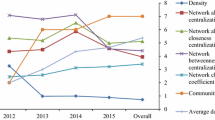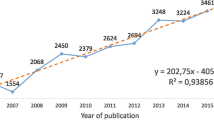Abstract
This paper analyzes whether methods from social network analysis can be adopted for the modeling of scientific fields in order to obtain a better understanding of the respective scientific area. The approach proposed is based on articles published within the respective scientific field and certain types of nodes deduced from these papers, such as authors, journals, conferences and organizations. As a proof of concept, the techniques discussed here are applied to the field of ‘Mobile Social Networking’. For this purpose, a tool was developed to create a large data collection representing the aforementioned field. The paper analyzes various views on the complete network and discusses these on the basis of the data collected on Mobile Social Networking. The authors demonstrate that the analysis of particular subgraphs derived from the data collection allows the identification of important authors as well as separate sub-disciplines such as classic network analysis and sensor networks and also contributes to the classification of the field of ‘Mobile Social Networking’ within the greater context of computer science, applied mathematics and social sciences. Based on these results, the authors propose a set of concrete services which could be offered by such a network and which could help the user to deal with the scientific information process. The paper concludes with an outlook upon further possible research topics.




Similar content being viewed by others
References
Barabasi, A., Jeong, H., Neda, Z., Ravasz, E., Schubert, A., & Vicsek, T. (2002). Evolution of the social network of scientific collaborations. Physica A, 311, 590–614.
Baur, M., & Benkert, M. (2005). Network comparison. In U. Brandes, & T. Erlebach (Eds.), Network analysis (pp. 318–340). Berlin: Springer.
Bensman, S. J. (2004). Pearson’s r and author cocitation analysis: A commentary on the controversy. Journal of the American Society for Information Science and Technology, 55(10), 935.
Björneborn, L. (2004). Small-world link structures across an academic web space—A library and information science approach. PhD Thesis, Royal School of Library and Information Science, Copenhagen, Denmark.
Brinkmeier, M., & Schank, T. (2005). Network statistics. In U. Brandes, & T. Erlebach (Eds.), Network analysis (pp. 293–317). Berlin: Springer.
Buzydlowski, J. W. (2003). A comparison of self-organizing maps and pathfinder networks for the mapping of co-cited authors. Ph.D. thesis, Drexel University.
Chen, C., & Carr, L. (1999). Trailblazing the literature of hyptertext: Author co-citation analysis (1989–1998). Proceedings of the 10th ACM conference on hypertext and hypermedia.
Chen, C., & Morris, S. (2003). Visualizing evolving networks: Minimum spanning trees versus pathfinder networks. In Proceedings of IEEE symposium on information visualization (pp. 67–74). IEEE Computer Society Press.
Chen, T. T., & Hsieh, L. C. (2007). On visualization of cocitation networks. Proceedings of the 11th international conference information visualization (pp. 470–475).
Clauset, A., Newman, M. E. J., & Moore, C. (2004). Finding community structure in very large networks. Physical Review E, 70 (066111).
Contextproject. URL http://www.cs.helsinki.fi/group/context/. [Online, 18. September 2009].
Corneil, D. G., & Gotlieb, C. C. (1970). An efficient algorithm for graph isomorphism. Journal of the ACM, 17(1), 51–64.
Egghe, L., & Leydesdorff, L. (2009). The relation between Pearson’s correlation coefficient r and Salton’s cosine measure. Journal of the American Society for Information Science and Technology, 60(5), 1027–1036.
Gaertler, M. (2005). Clustering. In U. Brandes, & T. Erlebach (Eds.), Network analysis (pp. 178–215).
Goffman, C. (1969). And what is your Erdös number? The American Mathematical Monthly, 76(7).
Groh, G., Hanstein, H., & Wörndl, W. (2009). Interactively visualizing dynamic social networks with dyson. In Proceedings of the IUI’09 workshop on visual interfaces to the social and the semantic Web (Vol. 2). Citeseer.
Hjørland, B. (2002). Domain analysis in information science—Eleven approaches—Traditional as well as innovative. Journal of Documentation, 58(4), 422–462.
Hjørland, B., & Albrechtsen, H. (1995). Toward a new horizon in information science: Domain-analysis. Journal of the American Society for Information Science, 46(6), 400–425.
Kaufmann, M., & Wagner, D. (2001). Drawing graphs: Methods and models (Vol. 2025). Springer.
Koschützki, D., Lehmann, K., Peeters, L., Richter, S., Tenfelde-Podehl, D., & Zlotowski, O. (2005). Centrality indices. In U. Brandes, & T. Erlebach (Eds.), Network analysis (pp. 16–61).
Kosub, S. (2005). Local density. In U. Brandes, & T. Erlebach (Eds.), Network analysis (pp. 112–142).
Lerner, J. (2005). Role assignments. In U. Brandes & T. Erlebach (Eds.), Network analysis (pp. 216–252).
Leydesdorff, L. (2008). On the normalization and visualization of author co-citation data: Salton’s cosine versus the jaccard index. Journal of the American Society for Information Science and Technology, 59(1), 77–85.
Leydesdorff, L., & Vaughan, L. (2006). Co-occurrence matrices and their applications in information science: Extending aca to the web environment. Journal of the American Society for Information Science and Technology, 57(12), 1616–1628.
Lin, X., White, H. D., & Buzydlowski, J. (2003). Real-time author co-citation mapping for online searching. Information Processing and Management, 39(5), 689–706.
Lu, H., & Feng, Y. (2009). A measure of authors’ centrality in co-authorship networks based on the distribution of collaborative relationships. Scientometrics, Online First.
Luukkonen, T., Tussen, R. J. W., Persson, O., & Sivertsen, G. (1993). The measurement of international scientific collaboration. Scientometrics, 28(1), 15–36.
Manning, C. D., Raghavan, P., & Schütze, H. (2008). Introduction to Information Retrieval.
McCain, K. W. (1986). Co-cited author mapping as a valid representation of intellectual structure. Journal of the American Society for Information Science, 37(3), 111–122.
McCain, K. W. (1989). Mapping authors in intellectual space: Population genetics in the 1980s. Communication Research, 16, 667–681.
McCain, K. W. (1990). Mapping authors in intellectual space: A technical overview. Journal of the American Society for Information Science, 41(6), 433–443.
McCain, K. W., Verner, J. M., Hislop, G. W., Evanco, W., & Cole, V. (2005). The use of bibliometric and knowledge elicitation techniques to map a knowledge domain: Software engineering in the 1990s. Scientometrics, 65(1), 131–144.
McFarland, D., & Bender-deMoll, S. (2009). Sonia—Social network image animator URL http://www.stanford.edu/group/sonia/. [Online, 03. Oktober 2009].
Messmer, B. T., & Bunke, H. (1998). A new algorithm for error-tolerant subgraph isomorphism detection. IEEE Transactions on Pattern Analysis and Machine Intelligence, 20(5), 493–504.
Newman, M. E. J. (2001a). Scientific collaboration networks. I. Network construction and fundamental results. Physical Review E, 64 (016131).
Newman, M. E. J. (2001b). Scientific collaboration networks. II. Shortest paths, weighted networks, and centrality. Physical Review E, 64 (016132).
Newman, M. E. J. (2001c). The structure of scientific collaboration networks. In Proceedings of the National Academy of Science of the USA, 98, 404–409.
Otte, E., & Rousseau, R. (2002). Social network analysis: A powerful strategy, also for the information sciences. Journal of Information Science, 28(6), 441.
Park, H. W. (2003). Hyperlink network analysis: A new method for the study of social structure on the web. Connections, 25(1), 49–61.
Porter, M. F. (1980). An algorithm for suffix stripping. Program, 14(3), 130–137.
Porter, M. A., Onnela, J. P., & Mucha, P. J. (2009). Communities in networks. URL http://ssrn.com/abstract=1357925. [Online, 13. Oktober 2009]
Rousseau, R., & Zuccala, A. (2004). A classification of author co-citations: Definitions and search strategies. Journal of the American Society for Information Science and Technology, 55(6), 513–529.
Schvaneveldt, R. W., Durso, F. T., & Dearholt, D. W. (1989). Network structures in proximity data. The Psychology of Learning and Motivation: Advances in Research and Theory, 24, 249–284.
Small, H. (1973). Co-citation in the scientific literature: A new measure of the relationship between two documents. Journal of the American Society for Information Science, 24(4), 265–269.
Small, H. (1981). The relationship of information science to the social sciences: A co-citation analysis. Information Processing and Management, 17(1), 39–50.
Small, H., & Sweeney, E. (1985). Clustering the science citation index using co-citations. I. A comparison of methods. Scientometrics, 7, 391–409.
Small, H., Sweeney, E., & Greenlee, E. (1985). Clustering the science citation index using co-citations. II. Mapping science. Scientometrics, 8, 321–340.
Thelwall, M. (2004). Social network analysis. In M. Thelwall, (Ed.), Link analysis: An information science approach. (See chapter 22 in URL http://linkanalysis.wlv.ac.uk/index.html), (pp. 213–217). Emerald Group Publishing Limited.
Thelwall, M., Vaughan, L., & Björneborn, L. (2005). Webometrics. Annual Review of Information Science and Technology, 39(1), 81–135.
Tsay, M. Y., Xu, H., & Wu, C. W. (2003). Author co-citation analysis of semiconductor literature. Scientometrics, 58(3), 529–545.
Ullmann, J. R. (1976). An algorithm for subgraph isomorphism. Journal of the ACM, 23(1), 31–42.
van Eck, N. J., & Waltman, L. (2008). Appropriate similarity measures for author co-citation analysis. Journal of the American Society for Information Science and Technology, 59(10), 1653–1661.
Wallace, M. L., & Gingras, Y. (2009). A new approach for detecting scientific specialties from raw cocitation networks. Journal of the American Society for Information Science and Technology, 60(2), 240–246.
White, H. D. (1990). Author co-citation analysis: Overview and defense. In C. L. Borgman (Ed.), Scholarly communication and bibliometrics (p. 85).
White, H. D. (2003a). Author cocitation and Pearson’s r. Journal of the American Society for Information Science and Technology, 54(13), 1250–1259.
White, H. D. (2003b). Pathfinder networks and author cocitation analysis: A remapping of paradigmatic information scientists. Journal of the American Society for Information Science, 54(5), 423–434.
White, H. D., & Griffith, B. C. (1981). Author cocitation: A literature measure of intellectual structure. Journal of the American Society for Information Science, 32(3), 163.
White, H. D., & McCain, K. W. (1998). Visualizing a discipline: An author co-citation analysis of information science, 1972–1995. Journal of the American Society for Information Science, 49(4), 327–355.
Yan, E., Ding, Y., & Zhu, Q. (2009). Mapping library and information science in china: A coauthorship network analysis. Scientometrics, Online First, 157.
Zhao, D., & Strotmann, A. (2008). Information science during the first decade of the web: An enriched author cocitation analysis. Journal of the American Society for Information Science and Technology, 59(6), 916–937.
Author information
Authors and Affiliations
Corresponding author
Rights and permissions
About this article
Cite this article
Groh, G., Fuchs, C. Multi-modal social networks for modeling scientific fields. Scientometrics 89, 569–590 (2011). https://doi.org/10.1007/s11192-011-0475-x
Received:
Published:
Issue Date:
DOI: https://doi.org/10.1007/s11192-011-0475-x




